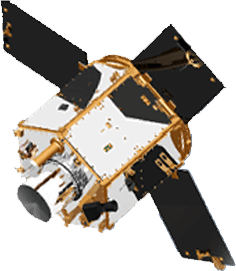RazakSAT
| RazakSat | |
|---|---|

|
|
| Type: | Earth observation satellite |
| Country: |
|
| COSPAR-ID : | 2009-037A |
| Mission dates | |
| Dimensions: | 180 kg |
| Size: | 1.2 × 1.2 × 1.0 m |
| Begin: | July 14, 2009 |
| Starting place: | Omelek |
| Launcher: | Falcon 1 |
| Orbit data | |
| Rotation time : | 98.3 min |
| Orbit inclination : | 9 ° |
| Apogee height : | 696 km |
| Perigee height : | 673 km |
RazakSat is a Malaysian earth observation satellite , which carries a high resolution camera and was launched on July 14, 2009 at 3:35 UTC with a rocket of the type Falcon 1 from the island of Omelek into orbit.
Details
RazakSat is a satellite developed and built in Malaysia in collaboration with the South Korean company Satreci and is also the first commercial payload of the Falcon 1 rocket operated by SpaceX . The start was postponed by more than four hours compared to the planning because there had been a minor problem in the helium system of the carrier and a few rain showers. Razaksat should have already been flying on the fourth Falcon 1, but was delayed by another test flight for safety reasons after the carrier made three false starts. Three minutes after launch, the payload fairing was detached, and about an hour after launch, the satellite was detached from the rocket and placed in its final orbit. The hexagonal, one meter high and about 180 kg heavy satellite carries a camera with a resolution of 2.5 m per pixel in the black and white area and 5.5 m for color images with a swath width of 20 km. It was built on the basis of the SI-200 satellite bus. The three-axis stabilization of the satellite is defined by four reaction wheels , and the power supply by gallium arsenide / germanium - solar cells (300 watts EOL) on a honeycomb substrate and cadmium-nickel batteries ensured with a capacity of 18 Ah. The satellite is remotely controlled via an S-band connection and the user data is transmitted in the X-band at up to 30 Mbit per second, with the data being temporarily stored on a 32 Gbit solid state drive on board. With its launch almost along the equator, RazakSAT flies at an orbit inclination of only nine degrees, which means that it flies over Malaysia up to a dozen times a day, more than any other earth observation satellite. The planned lifespan is three years.
The images from RazakSAT are to be available to scientists, commercial customers and authorities, with use in urban planning, crop monitoring, environmental monitoring, forestry and cartography being planned.
Web links
- ATSB: RazakSat
- YouTube: start video
Individual evidence
- ↑ N2YO: razaksat , accessed on 23 July 2009
- ↑ Stephen Clark: Commercial launch of SpaceX Falcon 1 rocket a success. Spaceflight Now, July 14, 2009, accessed July 23, 2009 .
- ↑ Gunter cancer: Satrec Initiative (SATRECI): SI 200th In: Gunter's Space Page. September 17, 2012, accessed October 5, 2012 .
- ↑ A big step for SpaceX. The Orion, July 16, 2009, accessed July 23, 2009 .